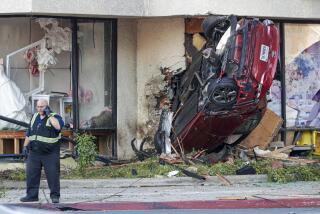Illuminating One of the Newest, Growing Trends in Auto Safety
- Share via
If you see a car coming toward you with its headlights on in the middle of the day, it may not be driver error. You may be looking at one of the newest trends in auto safety--daytime running lights, or as they are known in the auto industry, DRLs.
The always-on headlights are standard equipment on all 1997 General Motors cars made for the U.S. market, as well as on Volvos and Saabs. Other car companies are keeping an eye on how well the DRL-equipped cars sell and on whether or not it can be proved that they reduce accidents in this country.
At least one major trade organization, the Insurance Institute for Highway Safety, is already convinced.
“In other countries, where the lights are mandatory, studies have shown that daytime, multiple car collisions are reduced by about 10%,” said Allan Williams, senior vice president for research at the Washington-based institute.
“They simply make an approaching vehicle more conspicuous,” Williams said.
The trend began in Finland in 1972 when that country mandated that all headlights be on at all times during the dark, northern winter on rural roads. A decade later the law was expanded to apply year-round and in all areas.
Several other countries joined in. Now, headlights must be on at all times, with few exceptions, in Canada, Denmark, Hungary, Iceland, Norway and Sweden.
If a car is DRL-equipped, the driver doesn’t have to worry about turning on these lights; they come on automatically with the ignition. Depending on the car model, the DRLs might simply be the regular headlights, or they might be separate lights that are a bit less bright.
*
Daytime lights have never been mandatory for cars in the United States, but this country does have experience with the concept. Twenty-two states, including California, require that motorcycle headlights be turned on at all times.
Critics of DRLs have said they might be useful in northern countries, but not in the USA, where the natural light tends to be stronger. Also, some have complained that DRLs might cause glare in the eyes of oncoming drivers.
But in 1995, General Motors decided to go ahead and test DRLs. The company made them standard on two Chevrolet models--the Beretta and Corsica--two compact truck models and the Geo Metro.
Volvo, Saab and some models of Volkswagens went to DRLs that same year.
*
“It had been proven in other counties to be an effective and low-cost way to help avoid accidents,” said Gerald Holmes, a GM spokesman. “We figured that the time would come that the government would mandate them, and we would rather be proactive on this.”
Holmes admitted that auto companies often do not add safety features until required by law to do so. But anticipating a government mandate could save money.
“This way, we could gradually introduce them into our vehicles, instead of all at once,” he said.
In 1996 GM expanded the program to several more models and then made it the companywide standard for its 1997 cars.
The insurance institute says the additional power needed for DRLs is slight--only about $3 in gas costs per year. Bulbs do burn out more often, however.
As for glare, the institute said it has never shown it to be a problem, and Holmes said he is unaware of GM receiving any negative comments in that regard.
“Just about the only complaints I have heard is that some customers have said it infringes on their right to choose,” Holmes said. “We say that this improves safety, and most people approve of that.
“They can always take it to their dealer and get it [disconnected] if they want, but we feel the benefits outweigh any distractions.”







